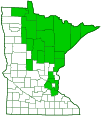green alder
(Alnus alnobetula ssp. crispa)
Conservation • Wetland • Description • Habitat • Ecology • Use • Distribution • Taxonomy
Description |
||
Each female catkin is on a long stalk 5 ⁄16″ to 1 3 ⁄16″ (8 to 30 mm) long. |
||
Height |
||
Up to 14′ |
||
Flower Color |
||
Bright yellow |
||
Similar Species |
||
Habitat |
||
Upland forests |
||
Ecology |
||
Flowering |
||
Early May to early june |
||
Pests and Diseases |
||
|
||
Use |
||
|
||
Distribution |
||||
|
Sources |
|||
| 4/29/2023 | ||||
Nativity |
||||
Native |
||||
Occurrence |
||||
Locally common |
||||
Taxonomy |
|||
| Kingdom | Plantae (Plants) | ||
| Division | Tracheophyta (Vascular Plants) | ||
| Subdivision | Spermatophytina (Seed Plants) | ||
| Class | Magnoliopsida (Dicots) | ||
Order |
Fagales (Beeches, Oaks, Walnuts, and Allies) | ||
Family |
Betulaceae (Birch) | ||
| Subfamily | Betuloideae | ||
Genus |
Alnus (alders) | ||
| Subgenus | Alnus | ||
| Species | Alnus alnobetula (green alder) | ||
Subordinate Taxa |
|||
Alnus crispa Alnus crispa var. elongata Alnus crispa fruticosa Alnus crispa var. mollis Alnus X hultenii Alnus crispa var. crispa Alnus viridis ssp. crispa Duschekia viridis |
|||
Synonyms |
|||
|
|||
Common Names |
|||
American green alder green alder mountain alder |
|||
Visitor Photos |
|||||
Share your photo of this plant. |
|||||
| This button not working for you? Simply email us at info@MinnesotaSeasons.com. Attach one or more photos and, if you like, a caption. |
|||||
|
|||||
MinnesotaSeasons.com Photos |
|||||
Twig |
|||||
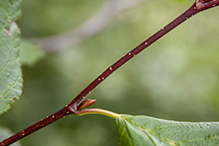 |
|||||
Leaf Upper Side |
|||||
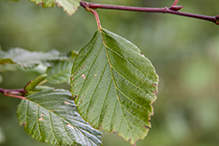 |
|||||
Leaf Underside |
|||||
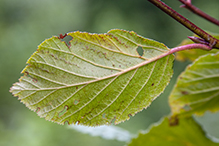 |
|||||
Pistillate Catkins |
|||||
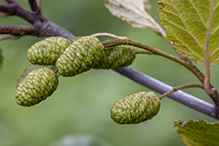 |
|||||
Developing Staminate Catkins |
|||||
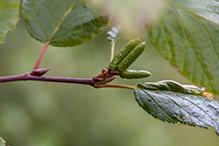 |
|||||

Visitor Videos |
|||
Share your video of this plant. |
|||
| This button not working for you? Simply email us at info@MinnesotaSeasons.com. Attach a video, a YouTube link, or a cloud storage link. |
|||
Other Videos |
|||
| Green Alder Swaying Leaves Stock Footage |
|||
About
Published on Feb 26, 2014 Download link: http://videohive.net/item/green-alder-swaying-leaves/4436624?WT.ac=solid_search_item&WT.seg_1=solid_search_item&WT.z_author=Christian_Fletcher Just the green alder leaves, blowing in the wind, in the morning after a rainy night. Alder leaves and sometimes catkins are used as food by numerous butterflies and moths. With a few exceptions, alders are deciduous, and the leaves are alternate, simple, and serrated. The flowers are catkins with elongate male catkins on the same plant as shorter female catkins, often before leaves appear; they are mainly wind-pollinated, but also visited by bees to a small extent. These trees differ from the birches in that the female catkins are woody and do not disintegrate at maturity, opening to release the seeds in a similar manner to many conifer cones. The largest species are red alder on the west coast of North America, and black alder, native to most of Europe and widely introduced elsewhere, both reaching over 30 m. |
|||

Visitor Sightings |
|||||
Report a sighting of this plant. |
|||||
| This button not working for you? Simply email us at info@MinnesotaSeasons.com. Be sure to include a location. |
|||||
|
|||||
MinnesotaSeasons.com Sightings |
|||||

|
Created: Last Updated: © MinnesotaSeasons.com. All rights reserved. |
